Three-Dimensional Flow Simulation by a Hybrid Two-Phase Solver for the Assessment of Liquid/Gas Transport in a Volute-Type Centrifugal Pump with Twisted Blades †
Abstract
:1. Introduction
2. Experiments
2.1. Experimental Set-Up and Pump Characteristics
2.2. Flow Regimes
3. Simulation Method
3.1. Flow Solver
3.2. Simulation Set-Up
4. Results and Discussion
5. Conclusions
Author Contributions
Funding
Acknowledgments
Conflicts of Interest
Abbreviations
| The following nomenclature is used in this manuscript | ||
| Model constants for | (-) | |
| b | Blade width | (m) |
| Velocity vector | (m s) | |
| & | Switching functions | (-) |
| Compression velocity | (m s) | |
| d | Diameter | (m) |
| Sauter mean diameter | (m) | |
| H | Pump head | (m) |
| k | Turbulence kinetic energy | (m2 s) |
| l | Line length | (m) |
| M | Momentum transfer terms | (kg m s) |
| Surface tension force | (kg m s) | |
| n | Rotational speed | (s) |
| Specific speed | s) | |
| Number density function | (-) | |
| Nondimensional specific speed | (-) | |
| p | Pressure | (Pa) |
| Q | Volume flow rate | (m3 s) |
| Effective stress tensor | (kg m s) | |
| s | Tip gap height | (m) |
| Nondimensional wall distance | (-) | |
| Volume fraction | (-) | |
| Inlet air volume fraction | (-) | |
| Specific dissipation | (s) | |
| Density | (kg m) | |
| ∇ | Divergence operator | (-) |
| Subscripts | ||
| 2 | Discharge area | |
| a | air | |
| B | Bubble | |
| max | Maximum | |
| opt | Best efficiency operating point | |
| t | Total | |
| w | Water | |
| Phase | ||
| The following abbreviations are used in this manuscript | ||
| 2D | two-dimensional | |
| 3D | three-dimensional | |
| CFD | Computational fluid dynamics | |
| EE2F | Euler-Euler two-fluid | |
| Exp | Experimental result | |
| G1 & G2 | Computational grids | |
| H2P | Hybrid two-phase | |
| PBM | Population balance modeling | |
| SAS | Scale-adaptive simulation | |
| URANS | Unsteady Reynolds-averaged Navier-Stokes | |
| VOF | Volume-of-Fluid | |
References
- Mansour, M.; Wunderlich, B.; Thévenin, D. Effect of tip clearance gap and inducer on the transport of two-phase air-water flows by centrifugal pumps. Exp. Therm. Fluid Sci. 2018, 99, 487–509. [Google Scholar] [CrossRef]
- Murakami, M.; Minemura, K. Effects of Entrained Air on the Performance of a Centrifugal Pump: 1st Report, Performance and Flow Conditions. Bull. JSME 1974, 17, 1047–1055. [Google Scholar] [CrossRef]
- Poelma, C. Measurement in opaque flows: A review of measurement techniques for dispersed multiphase flows. Acta Mech. 2020, 231, 2089–2111. [Google Scholar] [CrossRef] [PubMed]
- Perissinotto, R.M.; Monte Verde, W.; Biazussi, J.L.; Bulgarelli, N.A.V.; Fonseca, W.D.P.; de Castro, M.S.; de Moraes Franklin, E.; Bannwart, A.C. Flow visualization in centrifugal pumps: A review of methods and experimental studies. J. Pet. Sci. Eng. 2021, 203, 108582. [Google Scholar] [CrossRef]
- Yin, J.; Zhang, T.; Krull, B.; Meller, R.; Schlegel, F.; Lucas, D.; Wang, D.; Liao, Y. A CFD approach for the flow regime transition in a vane-type gas-liquid separator. Int. J. Multiph. Flow 2023, 159, 104320. [Google Scholar] [CrossRef]
- de Santis, A.; Hanson, B.C.; Fairweather, M. Hydrodynamics of annular centrifugal contactors: A CFD analysis using a novel multiphase flow modelling approach. Chem. Eng. Sci. 2021, 242, 116729. [Google Scholar] [CrossRef]
- Hundshagen, M.; Rave, K.; Nguyen, B.D.; Popp, S.; Hasse, C.; Mansour, M.; Thévenin, D.; Skoda, R. Two-Phase Flow Simulations of Liquid/Gas Transport in Radial Centrifugal Pumps with Special Emphasis on the Transition From Bubbles to Adherent Gas Accumulations. ASME J. Fluids Eng. 2022, 144, 101202. [Google Scholar] [CrossRef]
- Stel, H.; Ofuchi, E.M.; Alves, R.F.; Chiva, S.; Morales, R.E.M. Experimental Analysis of Gas–Liquid Flows in a Centrifugal Rotor. ASME J. Fluids Eng. 2020, 142, 031101. [Google Scholar] [CrossRef]
- Stel, H.; Ofuchi, E.M.; Chiva, S.; Morales, R.E. Numerical simulation of gas-liquid flows in a centrifugal rotor. Chem. Eng. Sci. 2020, 221, 115692. [Google Scholar] [CrossRef]
- He, D.; Ge, Z.; Bai, B.; Guo, P.; Luo, X. Gas–Liquid Two-Phase Performance of Centrifugal Pump Under Bubble Inflow Based on Computational Fluid Dynamics–Population Balance Model Coupling Model. ASME J. Fluids Eng. 2020, 142, 081402. [Google Scholar] [CrossRef]
- Zhang, F.; Zhu, L.; Chen, K.; Yan, W.; Appiah, D.; Hu, B. Numerical Simulation of Gas–Liquid Two-Phase Flow Characteristics of Centrifugal Pump Based on the CFD–PBM. Mathematics 2020, 8, 769. [Google Scholar] [CrossRef]
- Parikh, T.; Mansour, M.; Thévenin, D. Investigations on the effect of tip clearance gap and inducer on the transport of air-water two-phase flow by centrifugal pumps. Chem. Eng. Sci. 2020, 218, 115554. [Google Scholar] [CrossRef]
- Mansour, M.; Wunderlich, B.; Thévenin, D. Experimental Study of Two-Phase Air/Water Flow in a Centrifugal Pump Working with a Closed or a Semi-Open Impeller. In Proceedings of the ASME Turbo Expo 2018: Turbine Technical Conference and Exposition, Oslo, Norway, 11–15 June 2018. [Google Scholar] [CrossRef]
- Mansour, M.; Parikh, T.; Thévenin, D. Influence of the shape of the impeller blade trailing edge on single and two-phase air water flows in a centrifugal pump. In Proceedings of the Turbomachinery & Pump Symposia, Housten, TX, USA, 13–16 December 2020. [Google Scholar]
- Mansour, M.; Kopparthy, S.; Thévenin, D. Investigations on the effect of rotational speed on the transport of air-water two-phase flows by centrifugal pumps. Int. J. Heat Fluid Flow 2022, 94, 108939. [Google Scholar] [CrossRef]
- Schäfer, T.; Bieberle, A.; Neumann, M.; Hampel, U. Application of gamma-ray computed tomography for the analysis of gas holdup distributions in centrifugal pumps. Flow Meas. Instrum. 2015, 46, 262–267. [Google Scholar] [CrossRef]
- Schäfer, T.; Neumann-Kipping, M.; Bieberle, A.; Bieberle, M.; Hampel, U. Ultrafast X-Ray Computed Tomography Imaging for Hydrodynamic Investigations of Gas–Liquid Two-Phase Flow in Centrifugal Pumps. ASME J. Fluids Eng. 2020, 142, 041502. [Google Scholar] [CrossRef]
- Neumann, M.; Schäfer, T.; Bieberle, A.; Hampel, U. An Experimental Study on the Gas Entrainment in Horizontally and Vertically Installed Centrifugal Pumps. ASME J. Fluids Eng. 2016, 138, 12–19. [Google Scholar] [CrossRef]
- Gambao, J.; Prado, M.G. Visualization study of performance breakdown in two-phase performance of an electrical submersible pump. In Twenty-Sixth International Pump User Symposium, Texas, USA; Springer: Berlin/Heidelberg, Germany, 2010. [Google Scholar] [CrossRef]
- Barrios, L.; Prado, M.G. Experimental Visualization of Two-Phase Flow Inside an Electrical Submersible Pump Stage. J. Energy Resour. Technol. 2011, 133, 042901. [Google Scholar] [CrossRef]
- Trevisan, F.E.; Prado, M. Experimental Investigation of the Viscous Effect on Two-Phase-Flow Patterns and Hydraulic Performance of Electrical Submersible Pumps. J. Can. Pet. Technol. 2011, 50, 45–52. [Google Scholar] [CrossRef]
- Monte Verde, W.; Biazussi, J.L.; Sassim, N.A.; Bannwart, A.C. Experimental study of gas-liquid two-phase flow patterns within centrifugal pumps impellers. Exp. Therm. Fluid Sci. 2017, 85, 37–51. [Google Scholar] [CrossRef]
- Shao, C.; Li, C.; Zhou, J. Experimental investigation of flow patterns and external performance of a centrifugal pump that transports gas-liquid two-phase mixtures. Int. J. Heat Fluid Flow 2018, 71, 460–469. [Google Scholar] [CrossRef]
- Zhao, L.; Chang, Z.; Zhang, Z.; Huang, R.; He, D. Visualization of gas-liquid flow pattern in a centrifugal pump impeller and its influence on the pump performance. Meas. Sens. 2021, 13, 100033. [Google Scholar] [CrossRef]
- Yan, S.; Sun, S.; Luo, X.; Chen, S.; Li, C.; Feng, J. Numerical Investigation on Bubble Distribution of a Multistage Centrifugal Pump Based on a Population Balance Model. Energies 2020, 13, 908. [Google Scholar] [CrossRef]
- Si, Q.; Asad, A.; Wang, B.; Wang, P.; Bois, G.; Jianping, Y.; Kubar, A.A. Numerical Study on Gas-Liquid Two Phase Flow Characteristic of Multistage Electrical Submersible Pump by Using a Novel Multiple-Size Group (MUSIG) Model. Phys. Fluids 2022, 34, 063311. [Google Scholar] [CrossRef]
- Chen, Y.; Patil, A.; Chen, Y.; Bai, C.; Wang, Y.; Morrison, G. Numerical Study on the First Stage Head Degradation in an Electrical Submersible Pump With Population Balance Model. J. Energy Resour. Technol. 2019, 141, 022003. [Google Scholar] [CrossRef]
- Simon, L. Application of the MUSIG model to bubbly flows. AEAT-1096 AEA Technol. 1996, 230, 826. [Google Scholar]
- Liao, M.; Si, Q.; Fan, M.; Wang, P.; Liu, Z.; Yuan, S.; Cui, Q.; Bois, G. Experimental Study on Flow Behavior of Unshrouded Impeller Centrifugal Pumps under Inlet Air Entrainment Condition. Int. J. Turbomach. Propuls. Power 2021, 6, 31. [Google Scholar] [CrossRef]
- Egorov, Y.; Menter, F. Development and Application of SST-SAS Turbulence Model in the DESIDER Project. In Advances in Hybrid RANS-LES Modelling; Peng, S.H., Haase, W., Eds.; Notes on Numerical Fluid Mechanics and Multidisciplinary Design; Springer: Berlin/Heidelberg, Germany, 2008; Volume 97, pp. 261–270. [Google Scholar] [CrossRef]
- Hundshagen, M.; Rave, K.; Mansour, M.; Thévenin, D.; Skoda, R. 3D flow simulation by a hybrid two-phase solver for the assessment of liquid/gas transport in a volute-type centrifugal pump with twisted blades. In Proceedings of the 15th European Conference on Turbomachinery Fluid Dynamics & Thermodynamics, Paper n. ETC2023-326. Budapest, Hungary, 24–28 April 2023; Available online: https://www.euroturbo.eu/publications/conference-proceedings-repository/ (accessed on 1 June 2023).
- Gülich, J.F. Centrifugal Pumps; Springer: Berlin/Heidelberg, Germany, 2010. [Google Scholar] [CrossRef]
- Mansour, M.; Parikh, T.; Thévenin, D. Influence of Blade Pitch and Number of Blades of a Pump Inducer on Single and Two-Phase Flow Performance. In Proceedings of the ASME Turbo Expo 2020, New York, NY, USA, 21–25 September 2020; Volume 9. [Google Scholar] [CrossRef]
- Nguyen, B.D.; Popp, S.; Hundshagen, M.; Skoda, R.; Mansour, M.; Thévenin, D.; Hasse, C. Large Eddy Simulations of Turbulent Gas-Liquid Flows in a Diverging Horizontal Channel Using a Hybrid Multiphase Approach. ASME J. Fluids Eng. 2023, 145, 031501. [Google Scholar] [CrossRef]
- Wardle, K.E.; Weller, H.G. Hybrid Multiphase CFD Solver for Coupled Dispersed/Segregated Flows in Liquid-Liquid Extraction. Int. J. Chem. Eng. 2013, 2013, 128936. [Google Scholar] [CrossRef]
- Müller, T.; Limbach, P.; Skoda, R. Numerical 3D RANS Simulation of Gas-Liquid Flow in a Centrifugal Pump with an Euler-Euler Two-Phase Model and a Dispersed Phase Distribution. In Proceedings of the 11th European Conference on Turbomachinery Fluid Dynamics & Thermodynamics, Madrid, Spain, 23–27 March 2015. [Google Scholar]
- Schiller, L.; Naumann, A. Über die grundlegenden Berechnungen bei Schwerkraftaufbereitung. Z. Vereines Dtsch. Ingenieure 1933, 77, 318–321. [Google Scholar]
- Rzehak, R.; Krepper, E.; Liao, Y.; Ziegenhein, T.; Kriebitzsch, S.; Lucas, D. Baseline Model for the Simulation of Bubbly Flows. Chem. Eng. Technol. 2015, 38, 1972–1978. [Google Scholar] [CrossRef]
- Brackbill, J.; Kothe, D.; Zemach, C. A continuum method for modeling surface tension. J. Comput. Phys. 1992, 100, 335–354. [Google Scholar] [CrossRef]
- Hänsch, S.; Lucas, D.; Krepper, E.; Höhne, T. A multi-field two-fluid concept for transitions between different scales of interfacial structures. Int. J. Multiph. Flow 2012, 47, 171–182. [Google Scholar] [CrossRef]
- Kumar, S.; Ramkrishna, D. On the solution of population balance equations by discretization—I. A fixed pivot technique. Chem. Eng. Sci. 1996, 51, 1311–1332. [Google Scholar] [CrossRef]
- Prince, M.J.; Blanch, H.W. Bubble coalescence and break-up in air-sparged bubble columns. AIChE J. 1990, 36, 1485–1499. [Google Scholar] [CrossRef]
- Luo, H.; Svendsen, H.F. Theoretical model for drop and bubble breakup in turbulent dispersions. AIChE J. 1996, 42, 1225–1233. [Google Scholar] [CrossRef]
- Liao, Y.; Rzehak, R.; Lucas, D.; Krepper, E. Baseline closure model for dispersed bubbly flow: Bubble coalescence and breakup. Chem. Eng. Sci. 2015, 122, 336–349. [Google Scholar] [CrossRef]
- Menter, F. Two-equation eddy-viscosity turbulence models for engineering applications. AIAA J. 1994, 32, 1598–1605. [Google Scholar] [CrossRef]
- Kalitzin, G.; Medic, G.; Iaccarino, G.; Durbin, P. Near-wall behavior of RANS turbulence models and implications for wall functions. J. Comput. Phys. 2005, 204, 265–291. [Google Scholar] [CrossRef]
- Jasak, H. Error Analysis and Estimation for the Finite Volume Method with Applications to Fluid Flows. Ph.D. Thesis, Imperial College of Science, Technology and Medicine, London, UK, 1996. [Google Scholar]
- Patankar, S.; Spalding, D. A calculation procedure for heat, mass and momentum transfer in three-dimensional parabolic flows. Int. J. Heat Mass Transfer 1972, 15, 1787–1806. [Google Scholar] [CrossRef]
- Travin, A.; Shur, M.; Strelets, M.; Spalart, P.R. Physical and Numerical Upgrades in the Detached-Eddy Simulation of Complex Turbulent Flows. In Advances in LES of Complex Flows; Moreau, R., Friedrich, R., Rodi, W., Eds.; Fluid Mechanics and Its Applications; Springer: Dordrecht, The Netherlands, 2002; Volume 65, pp. 239–254. [Google Scholar] [CrossRef]
- Weller, H. Controlling the Computational Modes of the Arbitrarily Structured C Grid. Mon. Weather. Rev. 2012, 140, 3220–3234. [Google Scholar] [CrossRef]
- Warming, R.F.; Beam, R.M. Upwind Second-Order Difference Schemes and Applications in Aerodynamic Flows. AIAA J. 1976, 14, 1241–1249. [Google Scholar] [CrossRef]
- Sweby, P.K. High Resolution Schemes Using Flux Limiters for Hyperbolic Conservation Laws. SIAM J. Numer. Anal. 1984, 21, 995–1011. [Google Scholar] [CrossRef]
- Casimir, N.; Zhu, X.; Hundshagen, M.; Ludwig, G.; Skoda, R. Numerical Study of Rotor–Stator Interaction of a Centrifugal Pump at Part Load With Special Emphasis on Unsteady Blade Load. ASME J. Fluids Eng. 2020, 142, 081203. [Google Scholar] [CrossRef]
- Hundshagen, M.; Casimir, N.; Pesch, A.; Falsafi, S.; Skoda, R. Assessment of scale-adaptive turbulence models for volute-type centrifugal pumps at part load operation. Int. J. Heat Fluid Flow 2020, 85, 108621. [Google Scholar] [CrossRef]
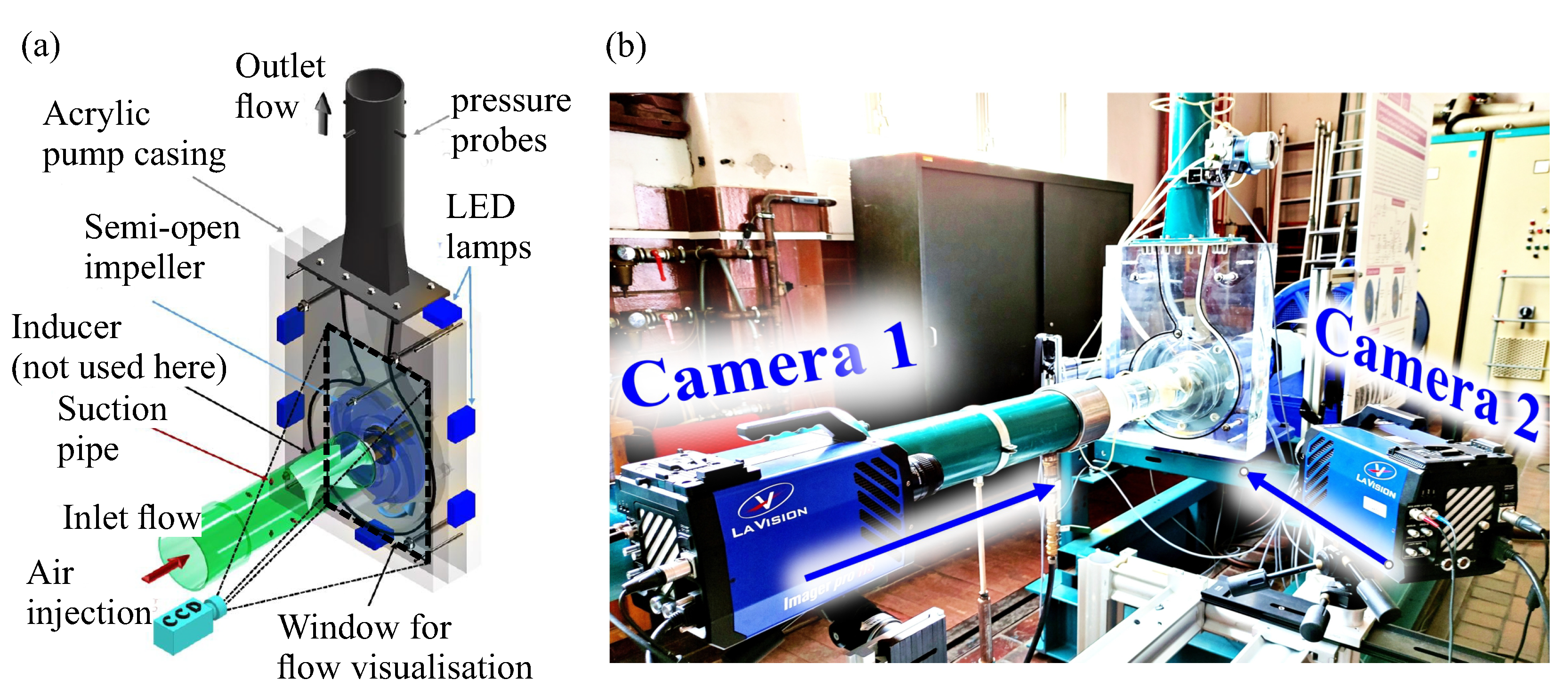
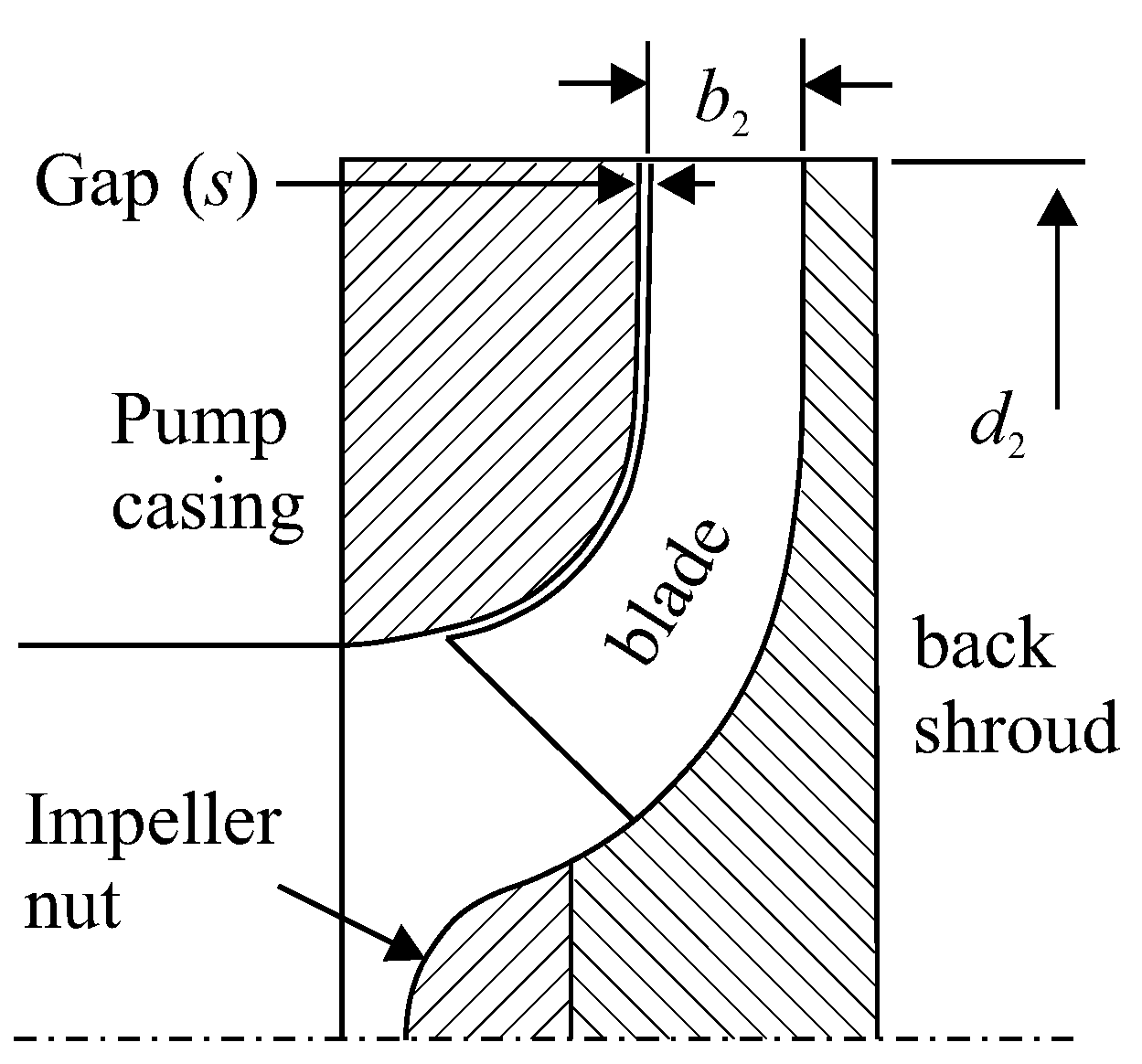
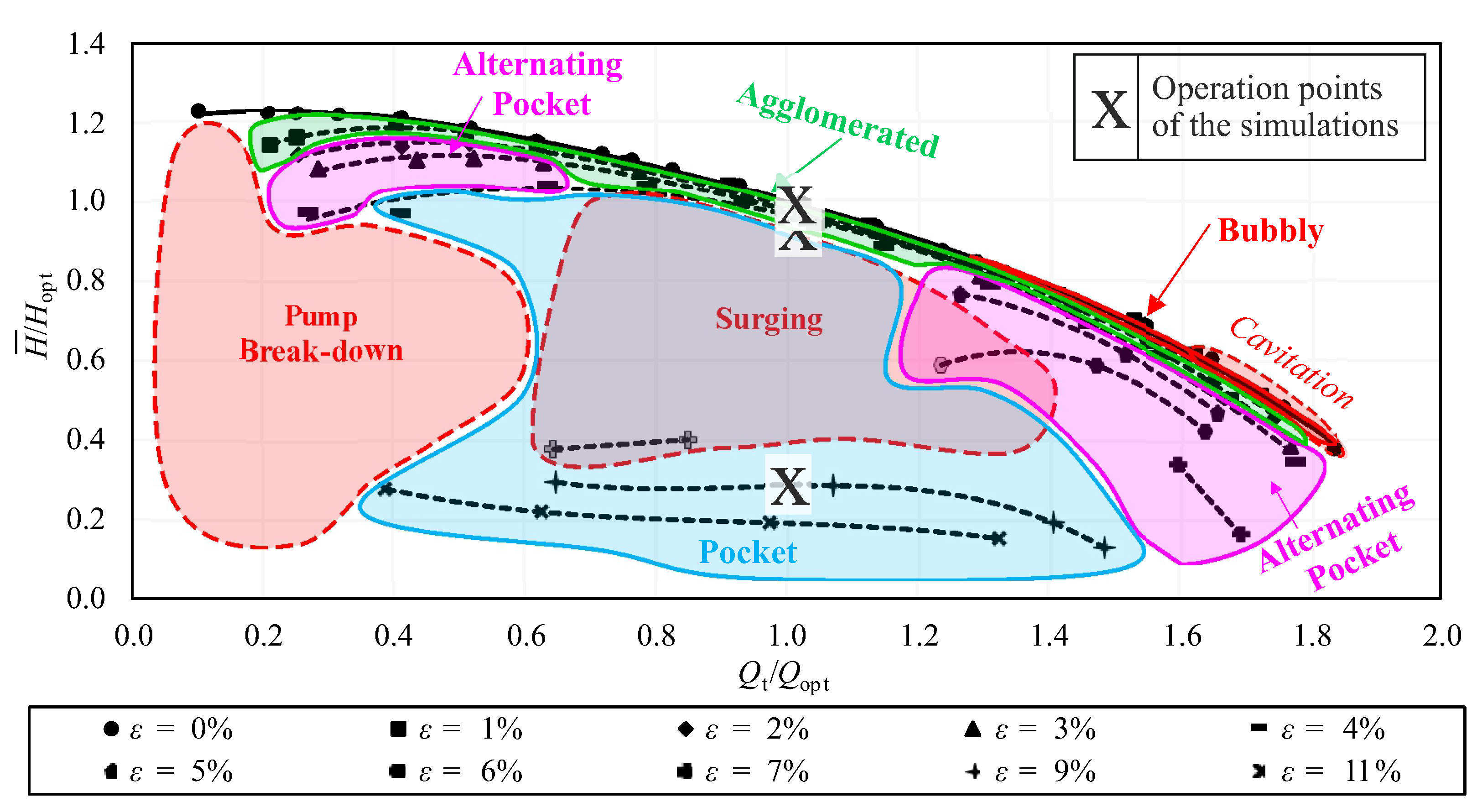
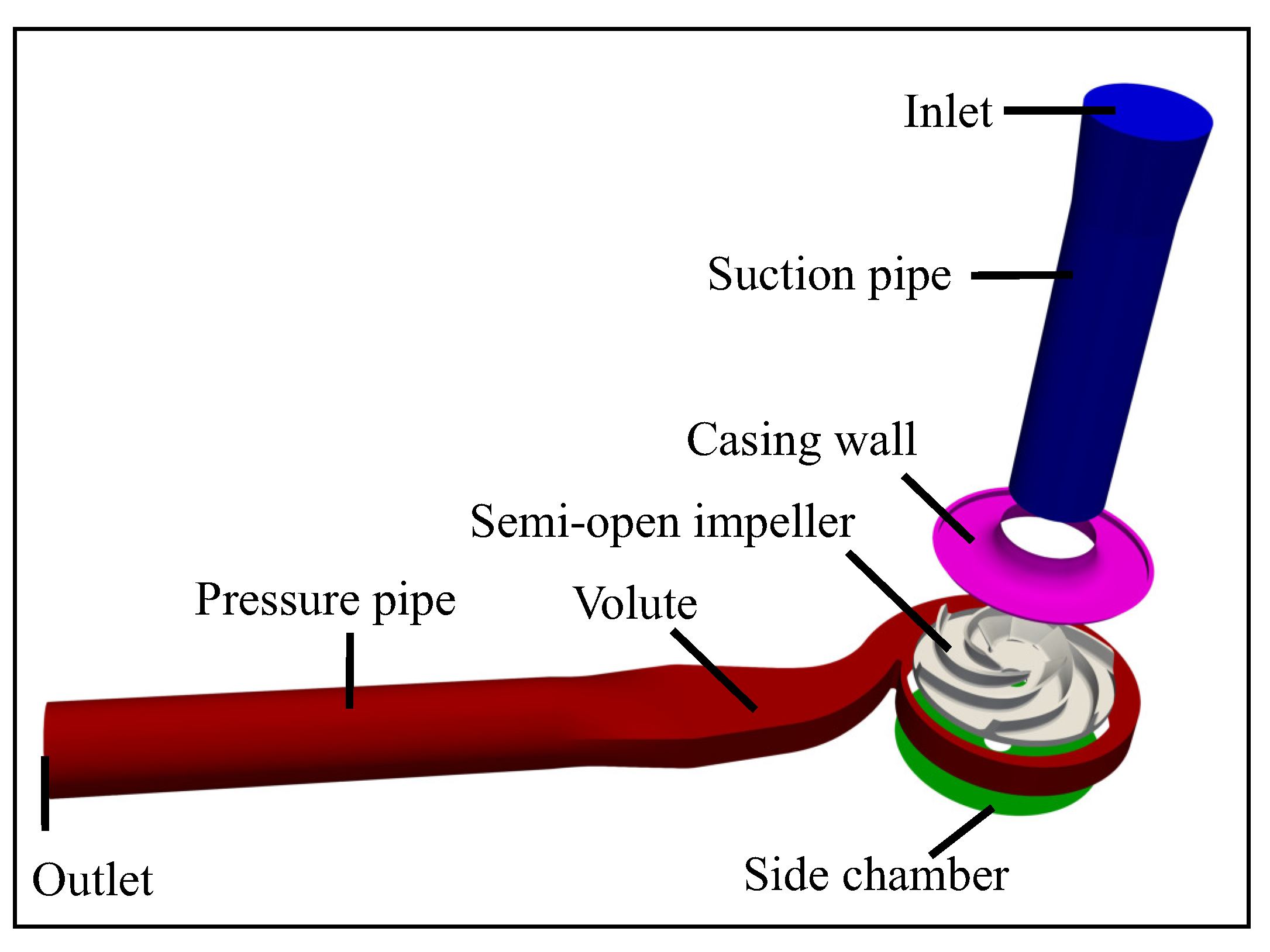
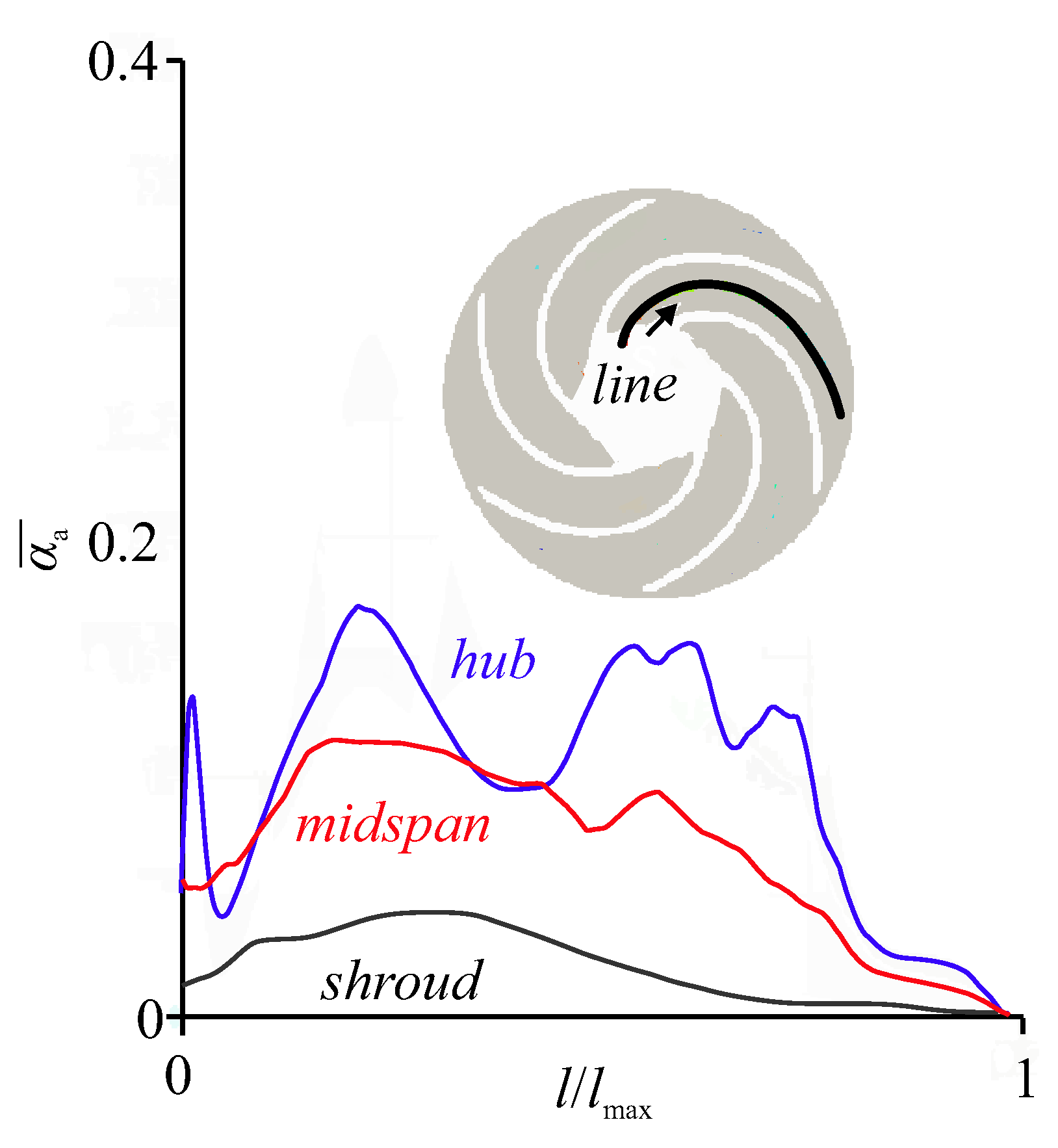

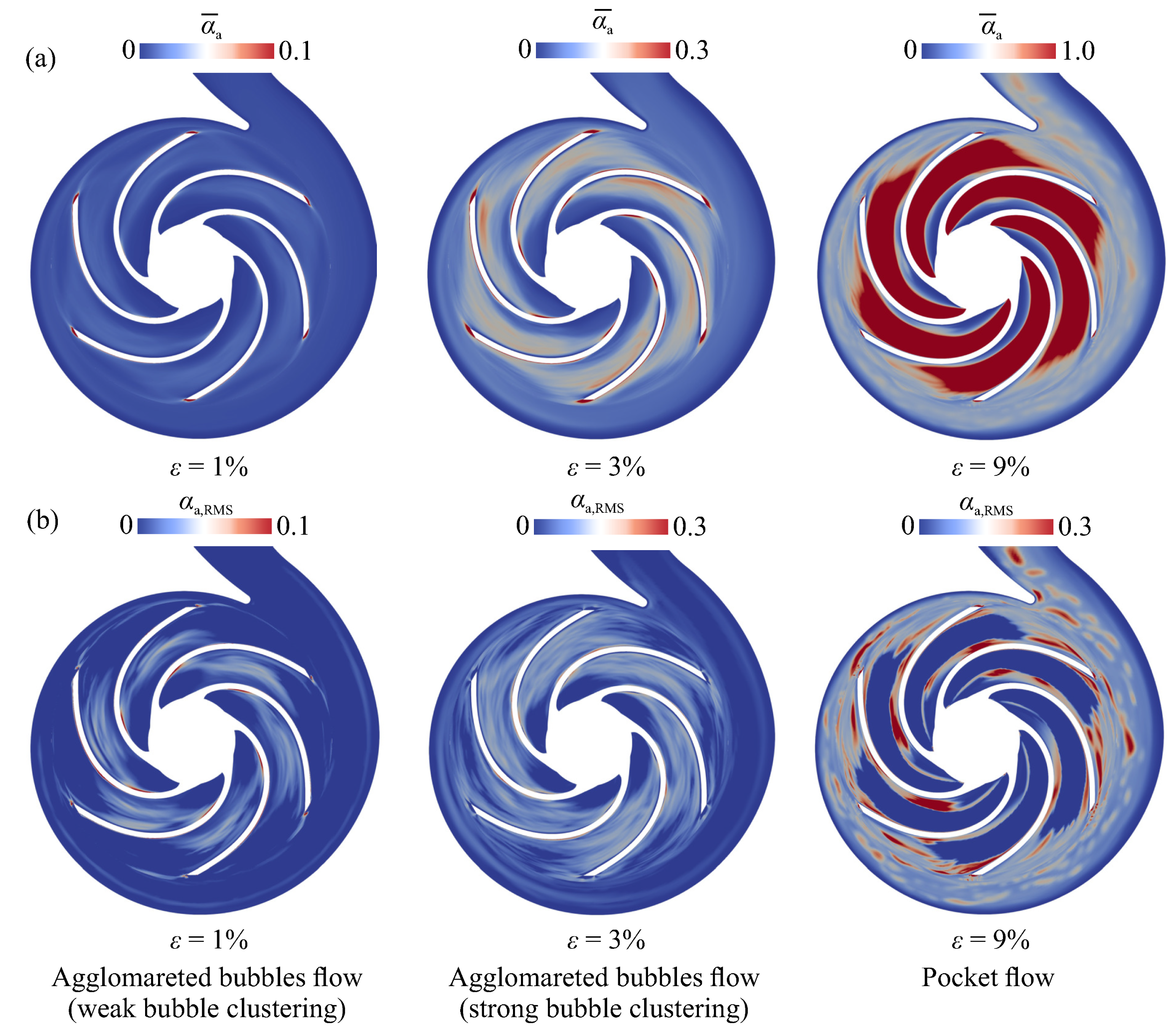
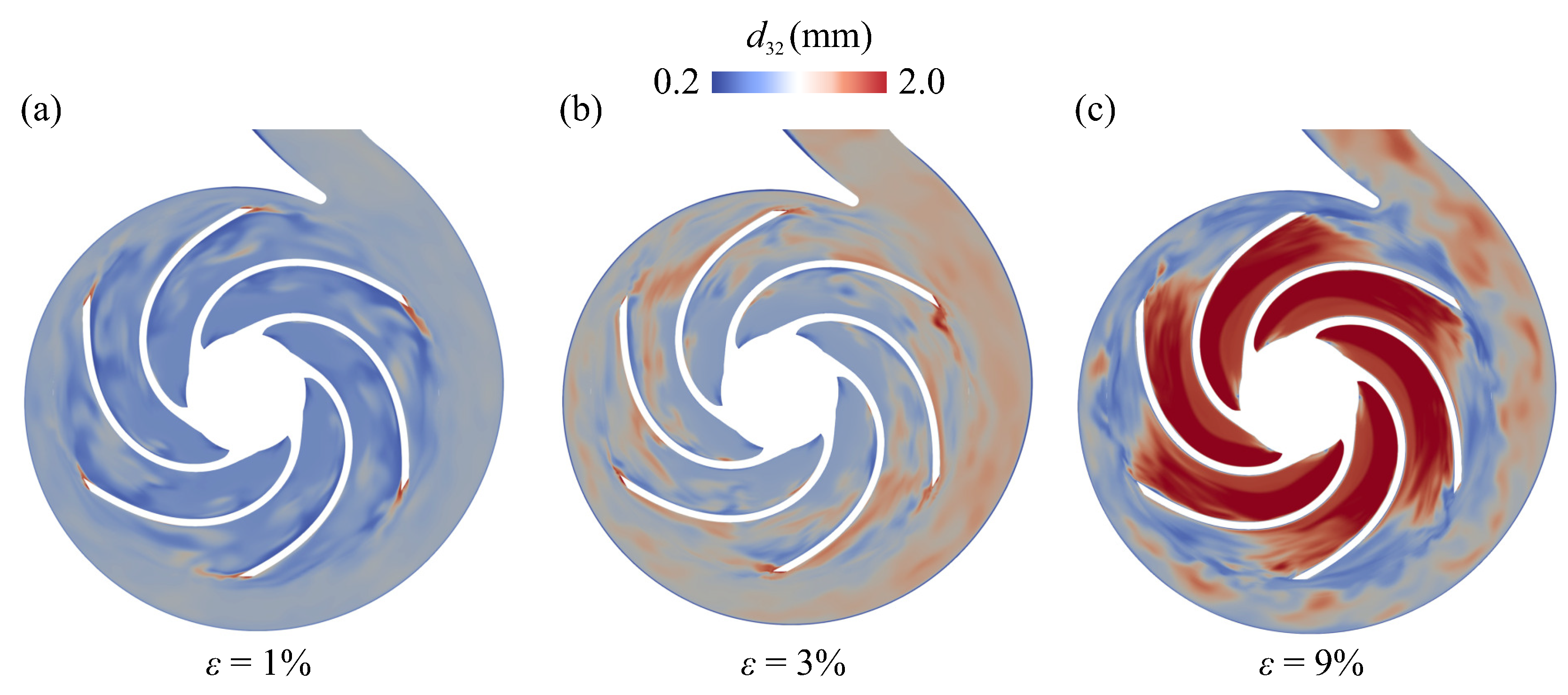
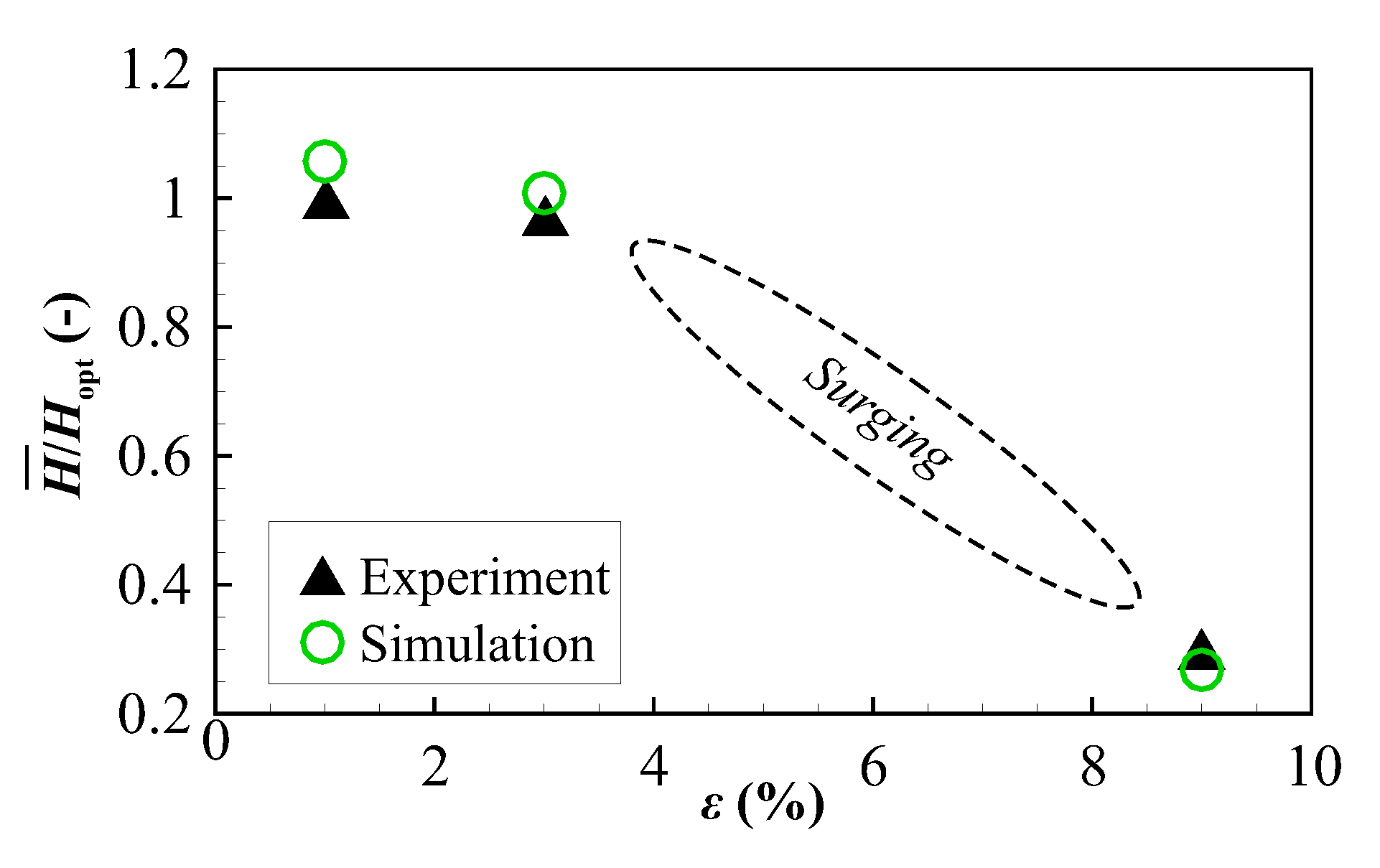
| Term | Scheme |
|---|---|
| Time discretization | First-order implicit Euler |
| Discretization of convective terms (momentum eqns.) | Second-order hybrid scheme [49]: LUST scheme of Weller [50] (Scale-resolving region) or Second-Order upwind of Warming & Beam [51] (URANS region) |
| Discretization of convective terms (phase fraction eqns.) | Second-order TVD with limiter of Sweby [52] (phase interface) or first-order upwind (disperse flow region) |
| Discretzsation of convective terms (size fraction eqns.) | Second-order TVD with limiter of Sweby [52] |
| Discretization of convective terms (k and eqns.) | First-order upwind |
| Name | # of Cells () | # of Tip Gap Cells | Non-Orthogonality | ||
|---|---|---|---|---|---|
| G1 | 3.5 | 7 | 27 | 6 | <70 |
| G2 | 32.2 | 14 | 9 | 3 | <70 |
Disclaimer/Publisher’s Note: The statements, opinions and data contained in all publications are solely those of the individual author(s) and contributor(s) and not of MDPI and/or the editor(s). MDPI and/or the editor(s) disclaim responsibility for any injury to people or property resulting from any ideas, methods, instructions or products referred to in the content. |
© 2023 by the authors. Licensee MDPI, Basel, Switzerland. This article is an open access article distributed under the terms and conditions of the Creative Commons Attribution (CC BY-NC-ND) license (https://creativecommons.org/licenses/by-nc-nd/4.0/).
Share and Cite
Hundshagen, M.; Rave, K.; Mansour, M.; Thévenin, D.; Skoda, R. Three-Dimensional Flow Simulation by a Hybrid Two-Phase Solver for the Assessment of Liquid/Gas Transport in a Volute-Type Centrifugal Pump with Twisted Blades. Int. J. Turbomach. Propuls. Power 2023, 8, 28. https://doi.org/10.3390/ijtpp8030028
Hundshagen M, Rave K, Mansour M, Thévenin D, Skoda R. Three-Dimensional Flow Simulation by a Hybrid Two-Phase Solver for the Assessment of Liquid/Gas Transport in a Volute-Type Centrifugal Pump with Twisted Blades. International Journal of Turbomachinery, Propulsion and Power. 2023; 8(3):28. https://doi.org/10.3390/ijtpp8030028
Chicago/Turabian StyleHundshagen, Markus, Kevin Rave, Michael Mansour, Dominique Thévenin, and Romuald Skoda. 2023. "Three-Dimensional Flow Simulation by a Hybrid Two-Phase Solver for the Assessment of Liquid/Gas Transport in a Volute-Type Centrifugal Pump with Twisted Blades" International Journal of Turbomachinery, Propulsion and Power 8, no. 3: 28. https://doi.org/10.3390/ijtpp8030028
APA StyleHundshagen, M., Rave, K., Mansour, M., Thévenin, D., & Skoda, R. (2023). Three-Dimensional Flow Simulation by a Hybrid Two-Phase Solver for the Assessment of Liquid/Gas Transport in a Volute-Type Centrifugal Pump with Twisted Blades. International Journal of Turbomachinery, Propulsion and Power, 8(3), 28. https://doi.org/10.3390/ijtpp8030028





